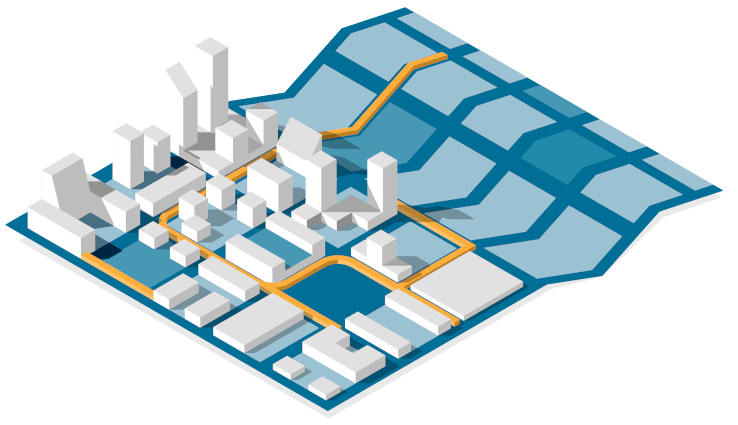
For network professionals to be able to document their OSP networks effectively, they need a specialized software solution that addresses the drawbacks highlighted with the traditional approach.
PATCH MANAGER is the leading software solution for cable and network asset management, and is designed at the core to support both outside and inside plant networks. PATCH MANAGER assists you to plan and troubleshoot by providing detailed modeling, visualization and reporting on all aspects of your end-to-end physical layer network infrastructure.
This article discusses the drawbacks of certain traditional approaches to documenting an OSP network and describes the benefits of taking an alternative approach by incorporating a specialized software solution into your tool set.
There are many important aspects to be considered during the design, planning, management and maintenance of an OSP network. Among the challenges faced by an OSP network professional are how to:
- Troubleshoot network issues
- Plan and manage changes to the network
Documentation is an integral part of these processes, but it is often overlooked. For an OSP network professional, it is vital to be able to visualize and report on their network assets and connectivity in order to address these challenges. Traditionally, network assets and connectivity have been tracked in a combination of spreadsheets, CAD drawings and Geographical Information Systems (GIS). Let’s dive into some of the issues encountered with this traditional approach:
Read more: Outside Plant & the Internet of Things
Spreadsheets
Spreadsheets are on-the-face-of-it ‘simple’ and ‘familiar’, but in an environment where detail and accuracy matters, they turn out to be error-prone, hard to maintain and provide no controlled means for change planning or tracking.
As a typical example, consider the scope for typo errors occurring when trying to plan changes to end-to-end port and splice connectivity mappings in spreadsheets. The consequences of the errors are ‘simple’ – the network connectivity data is inaccurate, and therefore can’t be relied upon for fieldwork or troubleshooting.

CAD drawings and GIS systems
CAD drawings are just that- drawings, and in terms of documenting network assets and connectivity, GIS systems are little more than advanced geographical drawings. Drawings may have their place in a static environment, but in a dynamic operational environment, the data that can be represented in a drawing is superficial and not fit for purpose. For example, consider if the layout of the fiber trunk cables in your network is maintained in CAD drawings. The cables would be illustrated in the drawings as graphical lines, perhaps with some notes or attributes tagged against them. The drawings thus provide a decent static representation of the cable routes, but they don’t constitute a useful operational database. They don’t provide crucial operational information such as:
- insight into which circuits the cables are carrying, and what the end-to-end connectivity of these circuits is
- insight into the inside plant aspects of the circuits, such as the bulkheads that the fiber strands are terminated on, and the active network assets that are providing the circuits
- insight into the splice joint mappings
- insight into the current availability and status of the fiber tubes and strands within the cables
In short, for network asset and connectivity management/troubleshooting, CAD drawings and GIS systems are ‘operationally useless’, as coined by one of our fiber operator customers.
In addition to the drawbacks discussed above, none of the traditional approaches are conducive to:
- team scenarios, where multiple network roles require concurrent access to plan and make changes to the network asset and connectivity data
- providing valuable reporting information, such as fiber circuit summaries, asset inventory and change audit trails
- integration with other systems within your enterprise, such as asset and network provisioning or monitoring systems
But what is the solution?
For network professionals to be able to document their OSP networks effectively, they need a specialized software solution that addresses the drawbacks highlighted with the traditional approach. In summary, a software solution that:
- helps quickly troubleshoot issues in the network by providing detailed visualization and reporting of the network assets and connectivity of the complete outside and inside plant, from the top-level geographical level all the way down to individual strands, splices, ports and connectors
- provides the ease of use of a spreadsheet, but that safeguards the data from erroneous entry and clutter
- allows network teams to seamlessly work together according to change management work flow processes
- provides a comprehensive means for systems to integrate with the network and connectivity data
Introducing PATCH MANAGER
PATCH MANAGER is the leading software solution for cable and network asset management, and is designed at the core to support both outside and inside plant networks. PATCH MANAGER assists you to plan and troubleshoot by providing detailed modeling, visualization and reporting on all aspects of your end-to-end physical layer network infrastructure.
Out-of-the-box, PATCH MANAGER seamlessly integrates with standard GIS protocols, whereby geographical maps from your GIS system or public map services can be linked into PATCH MANAGER within a few clicks. Network locations and components in PATCH MANAGER are then represented according to their exact geographical position. They are managed according to the full power of the PATCH MANAGER feature set, instead of being managed as mere geographical symbols in a GIS system.
PATCH MANAGER helps you to manage your change processes and audits through work orders and customizable work flows, and provides an extensive REST API for enterprise and engineering system integration.
If you would like to know more about PATCH MANAGER’s features and benefits, request a personal online demo here!
Download the printable version of this article here: